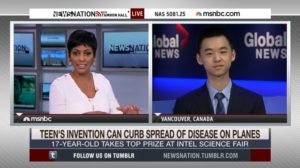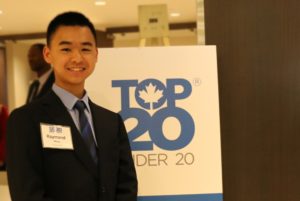By Jelani Odlum
Raymond Wang is a youth innovator from Vancouver, BC, who won the top prize at the 2015 Intel International Science and Engineering Fair (ISEF), the world’s largest international pre-college science competition, for his invention that circulates fresh air on planes to reduce transmission of germs between passengers. He delivered a TED Talk on his innovation and was selected as one of Canada’s Top 20 Under 20. Raymond currently attends Harvard University where he is majoring in Computer Science with a minor in Economics.
I recently spoke with Raymond Wang about his experiences as a young inventor, thoughts on how everyone can benefit from fundamental IP education, and belief that communities of innovators can help solve society’s biggest challenges at any age.
This interview has been edited and condensed for clarity and length.
Let’s talk about your award-winning invention for circulating fresh air on planes to reduce the transmission of germs. What initially got you interested in that subject and in public health?
I’ve always wanted to come up with ways to tackle large problems. I was initially focused on renewable energy work, then biomechanics, and then environmental management. But what prompted the invention for aircraft air circulation was an ebola outbreak that was heavily covered in the news. When it comes to infectious diseases, whether it’s H1N1 or other viruses, there is really a risk of it spreading to many different parts of the world through planes. Most of the academic investigation and R&D focuses on the outside of planes and how it flies, but there’s very little on the interior of cabins. Tackling this problem has important public health implications.
I started off by reading what others were doing in the space and I discovered ways to make improvements by finding out how aircraft circulation works. Through the use of simulations, software, and scale models, I was able to engineer a retrofit circulation solution that can be easily installed inside cabins.
I find it interesting that you engineered the solution using readily accessible technology. Is this a message you share with other innovators who may not have access to state-of-the-art equipment, but have a passionate interest in STEM?
Absolutely. But beyond that, the big lesson I learned was that if you reach out, there’s actually a whole community of people out there that’s willing to help. I had questions for experts while going through the simulations that I was able to get answered just by contacting them. And at one point, I needed to work with industry standard software packages that would normally cost over $20,000. I reached out to the developers and said, “Hey, I’m trying to tackle a problem that could potentially be impactful, are you willing to help?” And they allowed me to access that software for free. So whether it’s about getting expert advice, mentorship, or finding other resources, the key learning is if you’re well-researched and committed to solving a problem, all you have to do is ask.
Do you have a patent for your circulation device? If so, what was the process like?
Yes, I was able to get a US patent granted for this particular innovation. Before going into the competition I was already aware of the importance of protecting intellectual property, so I drafted a provisional application for the patent. I actually did it on the plane on the way to the fair. After the invention gained traction, I started the commercialization process with major players in the aerospace industry. During this time, I worked with a lawyer in my hometown of Vancouver to come up with an IP protection strategy, and then here at Harvard, I found resources to work with me to draft the application on a pro bono basis. The process shed a light into how the legal process works, and how startups can protect themselves while still making their research available for others to build on.
In your experience, are your classmates and peers informed on intellectual property and how to protect their inventions? What are your thoughts on IP education for students?
I’d say here at Harvard it’s a little skewed. We have a sizable community of people who are really passionate about solving problems and inventing so there’s a good amount of IP awareness. But broadly speaking, I think everyone can benefit from basic IP education. Figuring out how to navigate the timeline for patent applications and the defensibility of patents is important. Basic knowledge and intuition about approaching problems is also essential. I’m seeing more and more formal education programs pop up around this. Here on campus, we have a few classes that touch on the topic, so does MIT. We are making good progress. Obviously, institutes like Michelson IP are also helping to expand greater awareness of protecting IP.
Do you have any thoughts on improving access and success related to innovation education?
High school and middle school research competitions and science fairs are great. They challenge you to think creatively and critically about solving an issue you’re passionate about. It puts theoretical learning in the classroom into practice. I found those programs to be helpful in terms of personal learning and putting me in touch with a community of other innovators who were equally as passionate about solving the issues they cared about.
Are you involved in any outreach programs for students interested in STEM?
Definitely. I do some mentorship with Youth Science Canada which is the organization that ran many of the research competitions in high school. I’m glad that I’m able to now give back to them a little. I also run Sustainable Youth Canada which is about taking action and spreading awareness about major environmental issues like climate change. This summer I worked at a VC firm, and now I’m also able to share the insights I learned there through student organizations.
It seems like your interests are very interdisciplinary, how has that helped you in your innovation work so far?
I think having an interdisciplinary approach to thinking through solutions to problems is helpful. As an example, this aircraft innovation sits at the intersection of public health, biology, aerospace, computational physics and mechanical engineering. An interdisciplinary approach is good for taking things beyond just an idea and it exposes you to so many new and creative ways of thinking.
What are your goals after graduating from college, and where do you think you’d really like to focus your impact?
I learned in high school that I’m good at taking things from an idea to prototype. What I’d like to do next is take inventions I’ve developed towards full commercial scale. A great part of all journeys is that you don’t have to go it alone, and I’m looking forward to working with others in the startup ecosystem, whether here in Boston or on the West coast, perhaps the Bay Area. Overall, my goal is to use my experiences from college and extracurricular work, and apply them creatively in order to make a tangible social impact.
Interested in reading more stories resources like Raymond Wang’s? Join our mailing list for news & updates.
______________________
 The Michelson Institute for Intellectual Property, an initiative of the Michelson 20MM Foundation, addresses critical gaps in intellectual property education to empower the next generation of inventors. Michelson 20MM was founded thanks to the generous support of renowned spinal surgeon Dr. Gary K. Michelson and his wife, Alya Michelson. To learn more, visit 20mm.org.
The Michelson Institute for Intellectual Property, an initiative of the Michelson 20MM Foundation, addresses critical gaps in intellectual property education to empower the next generation of inventors. Michelson 20MM was founded thanks to the generous support of renowned spinal surgeon Dr. Gary K. Michelson and his wife, Alya Michelson. To learn more, visit 20mm.org.




so i am just wondering – its five years after Raymond Wang presented his invention to combat disease spreading on airplanes, with the onset of covid did the airline industry install Mr Wangs invention?
Love it! Helps with my project so much!!!